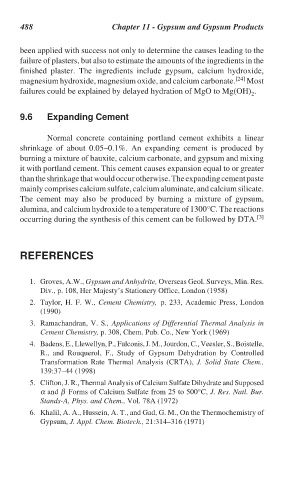Page 517 - Handbook of Thermal Analysis of Construction Materials
P. 517
488 Chapter 11 - Gypsum and Gypsum Products
been applied with success not only to determine the causes leading to the
failure of plasters, but also to estimate the amounts of the ingredients in the
finished plaster. The ingredients include gypsum, calcium hydroxide,
magnesium hydroxide, magnesium oxide, and calcium carbonate. [24] Most
failures could be explained by delayed hydration of MgO to Mg(OH) .
2
9.6 Expanding Cement
Normal concrete containing portland cement exhibits a linear
shrinkage of about 0.05–0.1%. An expanding cement is produced by
burning a mixture of bauxite, calcium carbonate, and gypsum and mixing
it with portland cement. This cement causes expansion equal to or greater
than the shrinkage that would occur otherwise. The expanding cement paste
mainly comprises calcium sulfate, calcium aluminate, and calcium silicate.
The cement may also be produced by burning a mixture of gypsum,
alumina, and calcium hydroxide to a temperature of 1300°C. The reactions
occurring during the synthesis of this cement can be followed by DTA. [3]
REFERENCES
1. Groves, A.W., Gypsum and Anhydrite, Overseas Geol. Surveys, Min. Res.
Div., p. 108, Her Majesty’s Stationery Office, London (1958)
2. Taylor, H. F. W., Cement Chemistry, p. 233, Academic Press, London
(1990)
3. Ramachandran, V. S., Applications of Differential Thermal Analysis in
Cement Chemistry, p. 308, Chem. Pub. Co., New York (1969)
4. Badens, E., Llewellyn, P., Fulconis, J. M., Jourdon, C., Veesler, S., Boistelle,
R., and Rouquerol, F., Study of Gypsum Dehydration by Controlled
Transformation Rate Thermal Analysis (CRTA), J. Solid State Chem.,
139:37–44 (1998)
5. Clifton, J. R., Thermal Analysis of Calcium Sulfate Dihydrate and Supposed
α and β Forms of Calcium Sulfate from 25 to 500°C, J. Res. Natl. Bur.
Stands-A, Phys. and Chem., Vol. 78A (1972)
6. Khalil, A. A., Hussein, A. T., and Gad, G. M., On the Thermochemistry of
Gypsum, J. Appl. Chem. Biotech., 21:314–316 (1971)

